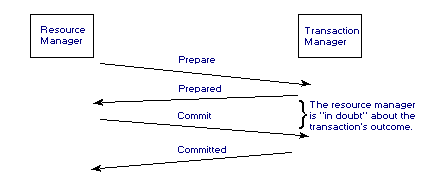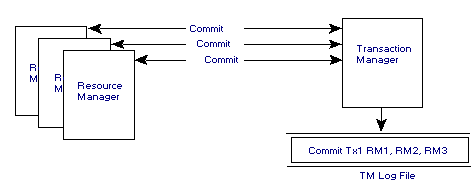
The transaction manager is the manager of transaction objects. It creates transaction objects and manages their atomicity and durability. Applications ask the transaction manager to create a transaction object by calling the transaction manager's BeginTransaction method.
When a resource manager first participates in a transaction, it calls the transaction manager to enlist in the transaction. The transaction manager tracks the resource managers who enlist in the transaction. Later the application calls Commit or Abort, or the transaction is aborted by a resource manager or a failure.
Commit and Abort are additional transaction methods on transactional objects. When asked to commit a transaction, the transaction manager initiates a two-phase commit protocol. During phase one, it asks all enlisted resource managers to prepare. During phase two, the transaction manager tells the resource managers whether the transaction committed or aborted. The two-phase commit protocol has many optimizations, including the read-only optimization and the transfer-of-commit optimization. MS DTC implements some of these optimizations, but the functionality, described in the figure below, remains the same: atomicity and durability.

The transaction manager keeps a log on disk. The log is a sequential file that records transaction events. The transaction manager records transaction starts, enlistments, and commit decisions in the log. During normal processing, the transaction manager only writes the log. If the transaction manager fails, it reconstructs the transaction's most recent state by reading the log. So, the transaction manager uses the log to make the transaction's state durable.

The transaction manager also provides an operations interface to manage transactions. It records important operational events in the system log. These events can be displayed by using the system event viewer. It has a graphical management interface that is integrated with SQL Enterprise Manager. The graphical management interface lets the operator configure the system, view transactions, and abort or commit in-doubt transactions.